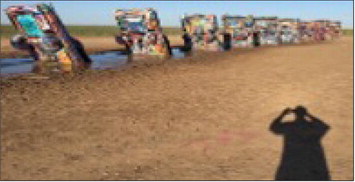The Cadillac automotive company was formed in 1902. The first Cadillacs were two-seat horseless carriages, but eventually Cadillac’s most distinctive feature – their tail fins – stand as flamboyant icons of American automotive design, inspired by the twin rudders of the Lockheed P-38 ‘Lightning’ fighter plane. The fins soared to dramatic heights, culminating in the extravagant 1959 Cadillac Eldorado, whose sweeping, rocket-like fins remain the most recognizable in automotive history.
Those tail fins symbolized postwar optimism and the spaceage dreams of mid-century America. They were bold, unapologetic and futuristic – reflecting a time when bigger meant better and chrome was king. The tail fin was a status symbol, a sculpted declaration of progress and prosperity.
I was casually acquainted with the guy who is responsible for Cadillac Ranch. He was Stanley Marsh 3, who purposely chose not to adopt the Roman numeral III in his name, as he thought that suffix was pretentious. Stanley was a wellknown businessman, entrepreneur and prankster in Amarillo, Texas where I grew up. Rumor was that he had inherited millions in his early 20’s and devoted the remainder of his life to eccentricity.
In 1974 he collaborated with a group of likewise unconventional artists – Chip Lord, Hudson Marquez, Doug Michels and Curtis Schreier, among others – who called themselves, “Ant Farm.”
This creative crew was an architecture, graphic arts and design collaborative. The group fancied itself as “an architecture collective that was more like a rock band.” Their name arose, according to Michels, when: “We were telling a friend that we would be doing underground architecture, like underground newspapers and underground movies, and she said, ‘Oh, you mean like an Ant Farm?’ and that’s all it took. That’s how Ant Farm worked: the right idea comes along, everybody acknowledges it is the right idea and instantly adopts it.”
When Ant Farm partnered with Stanley Marsh, their initial project involved half-burying 10 vintage Cadillacs, nose down, in a dirt cow pasture adjacent to Interstate 40, previously Old Route 66, just west of Amarillo. “Cadillac Ranch” has become a destination.
Stanley also designed what became known locally as ‘The Soft Pool Table.” This is a creation of monumentalsized inflated pool cues and a giant 8-ball, lying on a remote expanse of prairie land and visible only from the air. Visitors to Amarillo coming in from the west or north are the only viewers who can spot this unusual sight – by looking out of their airplane window.
Stanley had other creative inspirations. To perpetuate the myth of all Texans being tall, he once invited any citizen of Amarillo taller than six feet, four inches to a reception for a delegation of Japanese businessmen.
Among his last art installations were hundreds of quirky, diamond- shaped trafficstyle signs which were placed around Amarillo, mostly in the yards of folks, who donated $100 to the cause of “advancing art.”
Stanley’s insertion of art into the urban space in Amarillo was an innovative public art idea at the time, subverting the traditional and authoritarian nature of the gallery. A number of such signs are also displayed in Adrian, Texas, 45 miles west of Amarillo. Marsh was said to have wanted the signs to be placed in all the towns in Texas beginning with the letter “A.”
Most signs consist of just a few words.
“The body of a dead enemy always smells sweet” “No curfew. To live we must be up at all hours” And at least three such signs might well have represented Stanley’s personal mantras.
“Life is a dream that keeps me from sleeping” “Fantasy supplies what life doesn’t” “I’m not sure what I’m going to do” Some called these art projects eyesores with little or no artistic value. In response to the criticism, Stanley is quoted as saying, “Art is a legalized form of insanity, and I do it very well.”
Stanley Marsh 3 died in 2014 at the age of 76. He is buried at Llano Cemetery in Amarillo. His tombstone displays the epitaph that he had written decades earlier: “Thanks, everybody. I had a good time.”
Don Minnick is a clinical psychologist and organizational consultant and the author of books linked to business and the arts. He has found a home in the creative and culture-rich Wimberley valley. He is a Board Member of Wimberley Arts.Org. djmminnick@gmail. com








